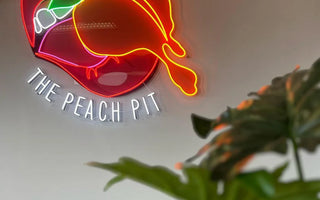Neon signs have been a fixture in advertising and pop culture history since their invention in the early 20th century. Their vibrant glow captivated passersby and consumers alike, making them symbols of modernity and dynamism. This article explores the evolution of neon signs in advertising and pop culture, and why they continue to have a significant impact today.
Discover more about neon sign
The Beginnings of Neon Signs
1. The Invention of Neon
The first neon signs were invented in 1910 by Georges Claude, a French physicist and chemist. His discovery of the luminescence of neon gases quickly found commercial use, and the first neon sign was installed in 1912 in Paris for a barber shop. From then on, neon signs spread throughout the world, becoming an indispensable tool for advertising.
2. Expansion in Advertising
In the 1920s and 1930s, neon signs gained popularity in major cities like New York and Las Vegas. With their visible glow day and night, they quickly became a central element of advertising, especially for local businesses, movie theaters, and restaurants. Neon revolutionized advertising displays, attracting consumers' attention at all hours.
Neon Signs and Pop Culture
1. Urban Symbols
In the 1950s and 1960s, neon signs became a symbol of urban sprawl and modern capitalism. They were ubiquitous in major cities, illuminating shopping malls, bars, and hotels. This period saw the emergence of Las Vegas and New York's Times Square as epicenters of neon, places where illuminated signs created unique cityscapes, capturing the spirit of the times.
2. Pop Culture Icons
Neon has also found its way into pop culture, appearing in numerous films, music videos, and works of art. Films such as Blade Runner (1982) immortalized neon signs in futuristic settings, transforming them into symbols of industrial and technological modernity. Neon imagery has become synonymous with 1980s nostalgia and is still used today to evoke a retro aesthetic.
Discover more about neon sign
Why is the History of Neon Signs Important?
1. An Advertising Legacy
The history of neon signs is inseparable from the evolution of modern advertising. They defined a new way to capture the public’s attention and allowed brands to stand out in crowded urban environments. Understanding this history allows businesses to appreciate the power of visual signage and innovate in their advertising methods.
2. A Lasting Cultural Influence
Neon signs are not just marketing tools; they are an integral part of visual culture and contemporary art history. Many brands and businesses still use neon signs to evoke a certain style or to create unique atmospheres. Neon is a way for businesses to connect with their customers through shared cultural elements.
Discover more about neon sign
Benefits for Businesses
1. Timeless Visibility
Neon signs continue to capture attention today, providing businesses with effective visibility. They are especially useful for stores, restaurants and bars that want to attract customers in busy shopping areas.
2. Attractive Aesthetics
Neon is often associated with a retro aesthetic, but it can also fit into modern decors. Businesses can use these signs to create a unique ambiance and make an impression on customers.


























